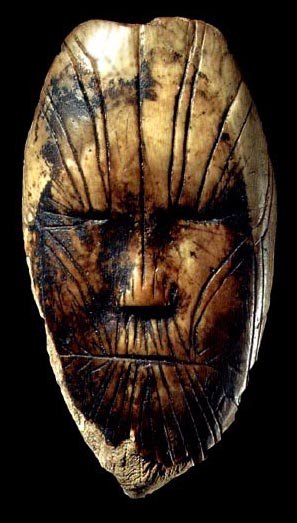At
what is now Independence Fiord, in the extreme High Arctic, cut
off from the rest of the world by "the great ice wall," Paleo-Eskimos,
hunted muskoxen, cooked over open fires, gathered birds' eggs during
the short summers, hunted hares, and fished from the shore. They
had lost their knowledge of the bow and arrow, of the kayak and
sea-going vessels. But with the gods and spirits they found there,
they were able to start over again.
"the
practices and beliefs of the shaman posed a model of behavior
for others to potentially utilize in times of personal distress.
Dissociating one's anxious mind into the realm of the supernatural
is a familiar human mechanism for handling problems unsolvable
by other means."
"Pindlingayak
means a fool, and Pindlerortok a mad or delerious person.
By degrees, as madness increases, disturbing the operation of
the senses and clouding the judgement and insight into things
present, the absent or concealed things and the events of the
future unfold themselves to the inner sight of the insane."
H.
Rink, Tales and Traditions of the Eskimos. Edinburgh, 1875.
This
morning I thought about giving away the backpack I’ve had
for over thirty years. In the mid-1970s, it carried supplies
up the mountain to my California hermitage. In the early 1980s,
it swayed to the rhythm of the steep trail into New Mexico's
Sangre de Cristo Mountains. So much sweat on the brow and running
down the back! So many pounding heartbeats as the
importance of magico-religious beliefs and their association
with Dorest technology is apparent in the most striking accomplishment
of the Dorset people: the creation of a body of art that is unique,
unexpected, and it struggled to keep pace. Now
my backpack carries only memories, "the
odd otherness of things."
Fearing
a runner, a dog, or a person looking up, would crush them, on
a twig I carried two parts of a worm, both wiggling, to the side
of the trail, where
a small purple flower clung to the cold earth.
a small purple flower clung to the cold earth.
R.
McGhee, Ancient People of the Arctic. Vancouver, B.C., 1996
Ivory
maskette 3,500+ years old, is the oldest known Paleo-
Eskimo portrait of a human.
Eskimo portrait of a human.
E.F.
Foulks, The Arctic Hysterias. Anthropological Studies #10
(1972)
D.
Abram. From an address given to the "Nature and Human Nature
Conference, " Pacifica Graduate Institute, Santa Barbara, CA.
March 2007
